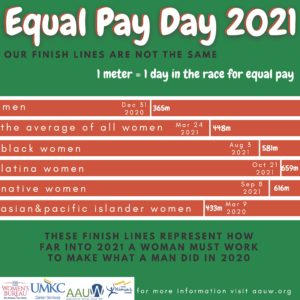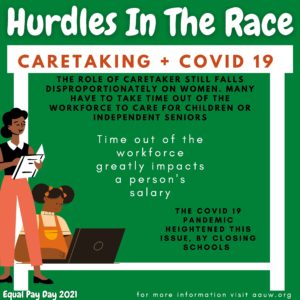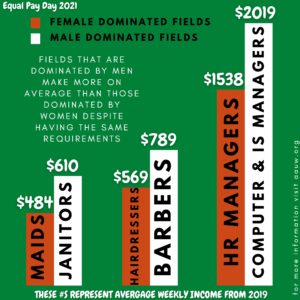By Mia Lukic
This year Equal Pay Day fell on March 24, 2021. This date represents how far into 2021 the average of all women must work in order to make what a man made in 2020. If this were a race, with the start line being January 1, 2020, the men’s finish line would be December 31, 2020, or 365 days (or meters for the sake of analogy).
The average of all women have to work 83 more days, or 448 days total. An intersectional perspective is essential in all evaluations so let us consider how it impacts Equal Pay Day. Black Women’s Equal Pay Day is August 3, 2021, 216 days longer than men. Latina Women’s Equal Pay Day is October 21, 2021 or 294 days longer than men. Native Women’s Equal Pay Day is September 8, 2021 or 251 days longer than men. Asian and Pacific Islander Women’s Day is March 9, 2021 or 68 days longer than men. The women’s races would be much longer than the men’s as their finish lines are much further away.
Upon first glance, we can see that Asian and Pacific Islander Women’s Day is earlier in the year, coming even before the average of all women. The AAUW stresses the importance of further examining the why. “Asian women’s experiences differ greatly depending on their subgroup. A previous analysis has shown that while women who report Indian or Chinese ethnicity or ancestry earn nearly as much as white men, women who identify as Filipina, Vietnamese and Korean are paid much less and all are subjected to the model minority myth, which erases ethnic subgroups’ diverse experiences as well as racism against Asian Americans as a whole” (AAUW).
The AAUW explores many factors that contribute to the gender pay gap such as the undervaluing of women’s work and discrimination of women for being mothers. They explain that women dominated fields are generally paid less than male dominated fields that require almost the exact same education and experience. Hairdressers make less than barbers and maids less than janitors, even though they are often seemingly synonymous professions. Women are also still disproportionately the caretakers and often take time out of their careers to focus on children and/or independent seniors. Time out of the workforce greatly impacts overall salary. The COVID19 pandemic has only heightened these issues as many schools shut down, eliminating that childcare and forcing women to stay home with children.
https://www.aauw.org/app/uploads/2020/12/SimpleTruth_2.1.pdf


